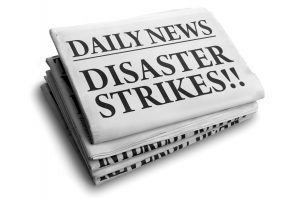
Weather-related catastrophes. Natural disasters. Crimes like hacking, burglary, vandalism, and arson. All of these things are unpredictable, and we hope unlikely, but the truth is, they happen.
Even safeguards cause problems sometimes – like a sprinkler system that squelches a fire and consequently floods a building. So how do you protect your business and your documents from disasters? How do you plan for the unexpected and unknown?
Planning is Preparedness
Every business should have a contingency plan or disaster recovery strategy, which should be well-documented and brought to the awareness of all employees. Here are five topics which should be covered in any boardroom disaster recovery meeting:
1) Know what’s at stake: What stands to be lost? Take inventory not only of the information that could be at risk, but also the contents of offices, warehouses, and satellite locations. Is there expensive equipment? Computers and servers? Products? How would the loss of these items affect the organization?
2) What is your Recovery Time Objective (RTO), or the amount of time you’d hope to remedy a disastrous event and be operating as normal? What would recovery entail, and how would it change the direction of the company’s strategic initiatives?
3) Are employees familiar with document retention schedules that may apply to your line of business?
Don’t keep things longer than you have to, or they could be problematic. In the event that your office moves to a new location, old documents can literally weigh you down and cost you thousands. On the other hand, make sure you’re compliant – easy access to important documents that are still relevant to operations, even if only in the eyes of the law, is crucial to preventing bottlenecks and black marks on surprise field exams.
4) Cost-effectiveness: Compare the costs of storage versus imaging, and then compare the costs of information, documents and equipment being lost, destroyed, or breached, compounded by the effects of widespread panic. News can spread faster than a wildfire, and should be placed in its own category of disasters. Don’t let the public hear about something you could’ve mitigated.
5) Conduct drills: You should know how long it takes to access critical information, storage facilities, satellite offices, and servers, and you should know which of your personnel are equipped to access these locations and what their schedules are, especially if they are remote employees. Everyone’s emergency contact information should be shared in case access to sensitive sites is only granted to key staff members. Lastly, all employees should be trained on emergency protocols.
Things to Consider

Your information should work for you, not the other way around. It should be easily accessible, quickly identifiable, and easily retrievable. The process of accessing this information should make you more efficient, and simplified workflows should be implemented to make every area of your business more productive when relying on that information. If you have to go to another physical location, pay someone to locate and retrieve information, and then have it scanned, you could be spending unnecessary time and money, not to mention jeopardizing your information.
Our Advice to You
Ease and convenience are not always preferable to security and efficiency when it comes to large volumes of sensitive and crucial information. Consider scanning your documents before having them stored, especially if they contain private client or employee information or are historical, financial, or legal in nature.
Converting data doesn’t have to be a pain. Before you consider re-prioritizing or hiring temporary personnel, look into outsourcing to a trusted partner. There are many solutions available, from cloud-based storage and backup to central document repositories with permissions-based points of access.


